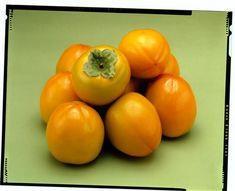
The bright orange delicacy was not introduced into Europe until the 17th century where it was grown for the next two centuries largely as an ornamental plant as well as for its wood which was highly prized by cabinet-makers.
But it was not really until the mid-20th century in Spain that interest in the fruit itself was really awakened in the regions where it grew, frequently alongside rural buildings or singly on narrow scraps of land in Catalonia, Andalusia and Valencia.
To begin with the fruit was really just consumed by the families who owned the trees, until traders started paying prices for it that were unthinkable for other fruits at the time. As a result a few pioneers started to plant up small plantations with the varieties that were common 60 years ago: Tomatero in the Segorbe area, and Picudo - also known as Costata - and Cristalino along the valley of the river Júcar (also spelt Xúquer in the Valencia dialect). And it was in this area that a variety - Rojo Brilliante - appeared which has since brought about something of a revolution in kakifruit production in Valencia and perhaps even further afield.
Rojo Brillante accounts for 95 per cent of commercial plantings of the fruit in the Valencia area over the last 15-20 years. This development has run in parallel with the evolution of Triumph in western provinces of Andalusia better known under its marketing name of sharonfruit. And it is these two varieties and production areas that make up the entirety of Spanish production of the fruit, although Ribera del Xúquer (the Júcar valley) is dominant.
The region’s climate - characterised by mild Mediterranean temperatures - has proved ideal for production as it tolerates frost during dormancy although late frosts can be damaging. However, it is not as sensitive as other fruits when it comes to lack of cold units either.
Kaki can be very adaptable when it comes to soil types, especially taking advantage of different rootstocks, but prefers a soil with moderate levels of limestone and good drainage.
The fruit steadily increased in terms of production although its role remained relatively small in the commercial sense until the 1990s.
But in 1997-98 consumption of Rojo Brillante began to alter. Traditionally the fruit was eaten in its over-mature state when its texture was almost jelly-like. Since then its consumption has also been promoted as a firmer fruit - persimmon kaki. The texture in this sate is more similar to that of an apple or a firm peach. Fruit is stickered with the Kaki DOP label bearing either Classic or Persimon, to indicate the different states of maturity of the traditional Rojo Brillante variety. In fact consumption of Persimon is now over-taking that of Classic.
The DOP regulatory council is responsible for the supervision of production, quality, flavour, packaging and appearance of the fruit.
It has also been producing publicity material in association with the 20 member companies that produce and market the fruit to highlight that there are two states of maturity in which it is possible to enjoy the versatile fruit.
Anecoop - Spain’s largest fruit and vegetable exporter - is also the biggest player in kaki and accounts for some 90 per cent of production under the DOP label.
The fruit is already well known in Germany, which leads consumption ahead even of Spain, with France in third place.
And herein lies the challenge for the DOP regulatory council, which is working to open up new markets especially as production is increasing and growers are keen to maintain the good prices they have been receiving for their fruit.
The UK is seen as a prime opportunity as kaki - in all its various guises as persimmon or sharonfruit - is still relatively unknown. To this end, the regulatory council is also busy carrying out research into post-harvest techniques as well searching for new varieties that will suit the climate and conditions in Valencia. Further opportunities exist for processed kaki products such as juice, preserves and jams and as a flavouring for desserts such as ice cream.
The fruit is also characterised by a high vitamin C content as well good levels of potassium and glucose, and anti-oxidant properties.